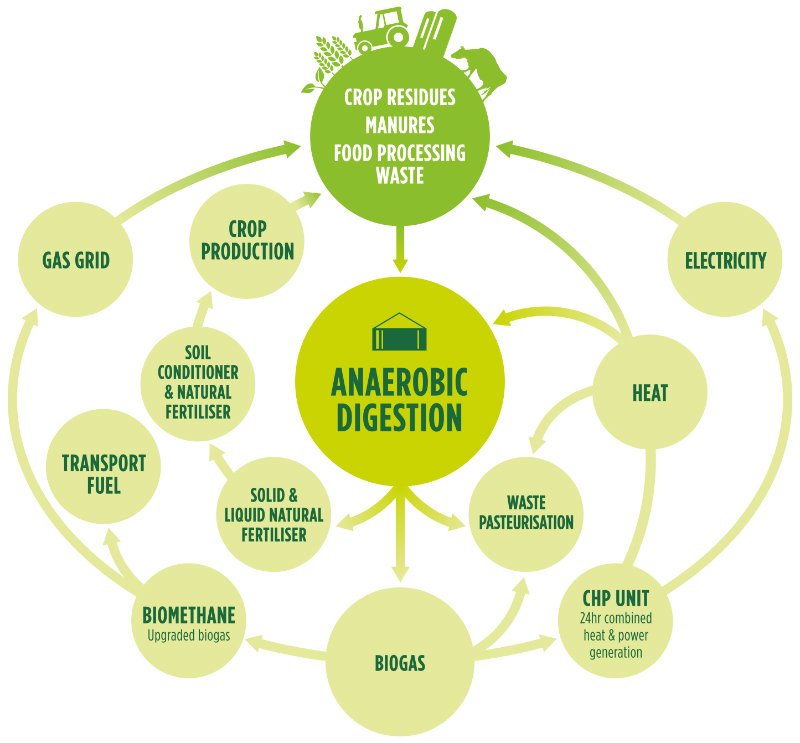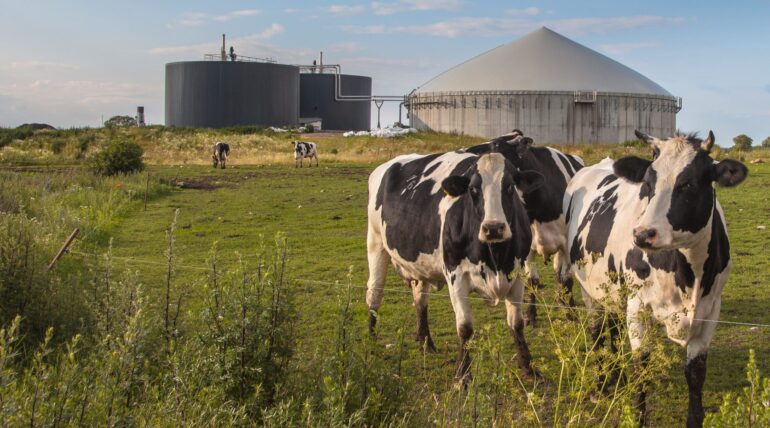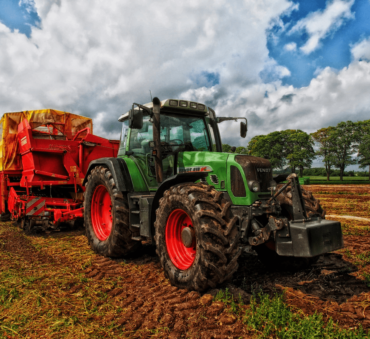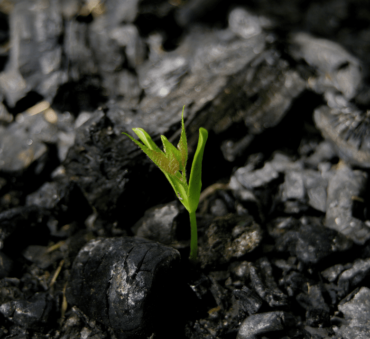As the world population grows, so does the amount of waste – particularly food and organic waste generated by agriculture and the food industry. And in today’s eco-conscious climate, it’s becoming increasingly important to have beneficial, environmentally- friendly solutions for the waste businesses produce. Fortunately, there has been a lot of ingenuity to combat this growing problem, and anaerobic digestion of food waste is one such solution. In fact, it’s an alternative that not only reduces waste but also generates some very valuable renewable resources.
In this post, we’ll take a closer look at how it works, its numerous benefits, and how you can implement it in your own business’ waste management strategy.
What is anaerobic digestion?
Anaerobic digestion is one of the most popular food waste management technology applications nowadays. It’s the collection of processes where microorganisms break down biodegradable matter, such as food waste and other organic waste, in the absence of oxygen. This is a process that even occurs naturally in the environment, such as swamps. But we have now been able to mimic this process on an industrial scale using large containers known as an anaerobic digester. In this container, microorganisms decompose organic matter and create food byproducts called biogas (a mixture of methane and carbon dioxide) and digestate which is rich in organic nutrients.
How anaerobic digestion of food waste works
Food waste makes up a significant part of the growing global waste problem. As populations increase and consumption patterns change, addressing the issue of food waste becomes even more critical. Fortunately, both food and most beverage waste are, of course, made up of organic compounds, making them an ideal candidate for anaerobic digestion.
How the anaerobic process works
Now let’s look at the biochemical processes of how anaerobic digestion works. Although many of these processes occur partly simultaneously, anaerobic digestion happens in four main steps:
Stage 1: Hydrolysis
The first stage of anaerobic digestion is hydrolysis. In this stage, complex organic materials such as carbohydrates, proteins, and lipids in food waste are broken down into simpler compounds like sugars, amino acids, and fatty acids. This breakdown is carried out by hydrolytic bacteria, which secrete enzymes called hydrolases. These enzymes cleave the chemical bonds in large organic molecules, making them more accessible for other microorganisms in the subsequent stages.
Stage 2: Acidogenesis
During the second stage, acidogenesis, fermentative bacteria convert the simple compounds produced in hydrolysis into volatile fatty acids (VFAs), alcohols, carbon dioxide, hydrogen, and other by-products. This stage is important for creating an acidic environment that promotes the growth of the microorganisms involved in the later stages of anaerobic digestion.
Stage 3: Acetogenesis
In the acetogenesis stage, acetogenic bacteria further break down the VFAs and other products generated during acidogenesis into acetic acid, hydrogen, and carbon dioxide. These compounds are important precursors for the production of methane in the final stage of the process. The acetogenic bacteria also play a role in maintaining a balance between acid production and consumption, ensuring that the overall process remains stable and efficient.
Stage 4: Methanogenesis
The final stage of anaerobic digestion is methanogenesis, whereby microorganisms called methanogenic archaea convert the acetic acid, hydrogen, and carbon dioxide generated in the previous stages into methane and carbon dioxide. There are two primary pathways for methane production: acetolactic methanogenesis and hydrogenotrophic methanogenesis. In acetolactic methanogenesis, archaea directly cleave acetic acid into methane and carbon dioxide. In hydrogenotrophic methanogenesis, archaea use hydrogen and carbon dioxide to produce methane and water.

What are the byproducts of the anaerobic digestion process?
The result of this process produces two valuable byproducts: Biogas and digestate. Why these byproducts are so important is because they can be harnessed to be used as valuable resources, creating a sustainable solution for waste management:
- Biogas, because of the production of methane, is flammable and can be used as an energy source to produce electricity and heat or further refined into renewable natural gas and fuel.
- Digestate, the byproduct left after the anaerobic digestion process, is rich in nutrients like nitrogen, phosphorus, and potassium, which makes it an effective fertilizer or soil conditioner for agricultural and land applications.
What is the difference between aerobic and anaerobic digestion?
Aerobic and anaerobic digestion are similar in many ways. Both are biological processes used to break down organic matter. However, the main difference between the two lies in the presence or absence of oxygen, the microorganisms involved, and the byproducts produced.
Oxygen availability and microorganisms
Aerobic digestion, also known as aerobic degradation, occurs in the presence of air or with oxygen. This is because the process utilizes aerobic microorganisms that require oxygen for their metabolic processes. Conversely, anaerobic digestion takes place in an oxygen-free environment as it involves a variety of bacteria and archaea that can function without oxygen.
Energy consumption and environmental impact
Aerobic digestion generally requires more energy input, as it requires continuous mixing and aeration to maintain the right oxygen levels. Although it still has many of its own advantages, it has a higher energy requirement. This makes it a less environmentally friendly option compared to the less energy-intensive anaerobic digestion.
Byproducts
Of course, the end-resulting by-products will also differ significantly. Aerobic digestion produces carbon dioxide, water, and a stabilized solid residue known as compost or biosolids. These byproducts can be used as a soil amendment or fertilizer. While anaerobic digestion, as we now know, produces biogas and digestate.
Why is anaerobic digestion of food waste environmentally friendly?
Although the by-products produced are a great advantage on their own, the benefits of anaerobic digestion offer that and more.
- Diversion from landfills: By processing organic materials like food scraps and agricultural waste, we can lower the amount of waste ending up in landfills and prevent the resulting pollution from emissions.
- Nutrient Recovery: Digestate can be used as an eco-friendlier alternative for soil amendment. This reduces the need for chemical fertilizers and helps conserve valuable nutrients.
- Renewable Energy Generation: The renewable energy power of biogas reduces our reliance on fossil fuels and lowers greenhouse gas emissions.
- Soil Health Benefits: Applying digestate to agricultural land improves soil health by increasing organic matter content, promoting plant growth, reducing soil erosion and nutrient runoff, alleviating soil compaction, and improving water retention.
Other benefits of anaerobic digestion technology
Anaerobic digestion is a popular food technology trend that also hosts several business and economic benefits too:
- Cost savings: By utilizing waste as a feedstock for anaerobic digestion, businesses can help save on waste disposal costs.
- Revenue generation: The resulting biogas can be sold as electricity, heat, or upgraded biomethane, providing an additional revenue stream. Additionally, digestate can also be sold as organic fertilizer to agricultural businesses or local farmers.
- An effective waste management compliance solution: It offers an efficient and sustainable waste management solution for businesses, industries, and municipalities. This helps them comply with environmental regulations and reduce landfill usage.
- Corporate social responsibility (CSR): Implementing anaerobic digestion systems can enhance a company’s reputation for sustainability and environmental stewardship. This is likely to attract customers and investors who prioritize eco-friendly practices.
Partner with an experienced company to recycle your food waste the right way
Anaerobic digestion of food waste offers a multitude of benefits. This makes it an essential and viable solution for sustainable waste management and renewable energy production.
However, to maximize these benefits and ensure that your waste is properly taken care of (and within regulatory standards) it is crucial for businesses to partner with experienced and reputable food recycling company. Partnering with a knowledgeable and committed organic waste recycling company like Shapiro ensures that you receive the highest level of expertise and support throughout the process.
Baily Ramsey, an accomplished marketing specialist, brings a unique blend of anthropological insight and marketing finesse to the digital landscape. Specializing in educational content creation, she creates content for various industries, with a particular interest in environmental initiatives.



